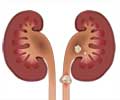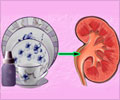- Astronauts more prone for kidney stones
- Due to logistics reason, detection and treatment in space is not feasible
- Burst Wave Lithotripsy (BWL) is compact and less heavy than conventional methods
- BWL can be used for other problems too like stopping bleeds and bone strengthening in space
HURDLES IN KIDNEY STONE MANAGEMENT IN SPACE - A BIG CHALLENGE
Either a shockwave lithotripsy is done where in the patient is made to lie down on a refrigerator like machine and large amounts of ultrasound waves are focused to break the stone or using an endoscopic approach and breaking the kidney or bladder stone using laser under direct vision.However due to the technicality and size of the machines used in these methods of treatment, this is not very feasible in outer space. Several data from NASA suggests that the astronauts are very much prone to develop kidney stones. And so if the astronaut does not pass the stone in the urine they might cause various complications and they would need to be called back from the mission to get treatment on Earth. One such incident has been recorded in NASA ISS (international space station). But as far as Mass mission is concerned sending back the person is not very possible.
And another hurdle is in the detection of the kidney stone itself. The kidney stones are generally detected using X-rays, ultra-sound and Computed tomography scans. But due to the heaviness of the machinery involved it is not suitable for space travel.
PORTABLE ULTRASOUND AND BURSTWAVE LITHOTRIPSY- A STEP FORWARD
The research team at the University of Washington’s Applied Physics Lab are working to solve this difficult space scenario. The team is working on developing a portable Ultrasound machine which will help to detect and disintegrate the kidney stones without the need for surgery or large equipments. This research is funded by the National Space Biomedical Research Institute.This technology focuses Ultrasound waves to detect the exact location of the stone in the kidney or the ureter and then uses short bursts of sound energy to break the stone into tiny pieces, small enough for the astronaut to pass in urine. “Originally it was being experimented for use in blunt trauma where we can focus ultrasound and stop bleeding,” Michael Bailey, the principle investigator of the research, said. “Then we realized that kidney stones were a bigger risk because bones are de-mineralizing (in space more rapidly) and that will increase the likelihood of stones and require treatment.”
Based on the mechanism of Shockwave lithotripsy, Adam Maxwell, an assistant professor of Urology at UW has developed Burst wave lithotripsy (BWL) which uses smaller, more frequent bursts of ultrasound to break the stone. Anne Zwaschka, a student working with the team explained that the difference between shock wave and burst wave lithotripsy is that the older technique is like breaking the stone with a hammer and in burst wave is like chiseling away the stone gradually. A big advantage with Burst wave is regarding the equipment which is lighter, more compact and uses lesser energy which is suitable for usage in space.
Now that the challenge of focusing the wave has been crossed, soon the research team will move on to testing BWL’s abilities, finding out its possible side effects and drawbacks. Eventually they will start doing clinical trials. BWL can also be used in various other problems faced by the astronauts in space like stopping bleeding, strengthening bones or even performing ultrasound surgery, without breaking the patients’ skin. Due to the flexibility of its software, apps can also be developed to extend its functionality.
Similar technology is being used in Swedish Medical Centre in Seattle to treat patients with tremors without involving invasive and dangerous brain surgeries and also in some medical centers in treatment of cancer prostate with good results.
References:
- Kidney Stones in Adults - (https://www.niddk.nih.gov/health-information/health-topics/urologic-disease/kidney-stones-in-adults/Pages/facts.aspx)















